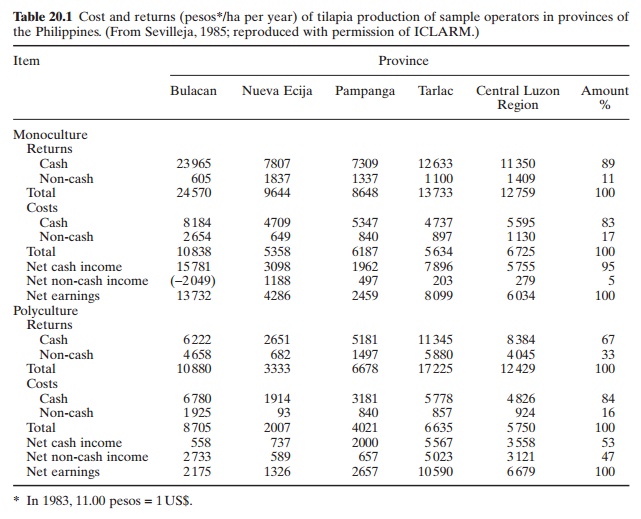Chapter: Aquaculture Principles and Practices: Tilapias
Economics - Tilapias
Economics
The
economics of tilapia farming depend very much on the availability of suitable
markets for the product. In extensive and simple small-scale rural farming,
where the size of the product is not a major concern and no supplementary
feeding is involved, the operation can be profitable when appropriate
management measures are employed. In semi-intensive or intensive systems the
cost of feeds, labour and, in some cases, water management become quite high
and these can be compensated only by appropriate market prices for the product.
In most African countries a good percentage of the consumers prefer tilapia,
and they can therefore be sold at prices comparable to many other good-quality
food fish. But in other parts of the world, where tilapias are exotic species,
considerable market promotion is required. As mentioned in the previous
section, the most important factor in developing a market for tilapia is the
size of the fish, and the main thrust of recent improvements in culture
technologies has been to obtain marketable-size products in as short a time as
possible.
Within
the limits of technological constraints, there is considerable variation in the
profitability of tilapia farming, between different types and sizes of
operations. This is clearly brought out by the costs and returns of sample
operations in different provinces of Central Luzon (Philippines) reported by
Sevilleja (1985), which are reproduced in Table 20.1. The data relate to
land-based fresh-water fish ponds for the calendar year 1982, collected during
1983. The capital investment per hectare varied between the provinces, from 13
058 pesos in Bulacan (11.00 pesos for 1 US$ in 1983) to 29661 pesos in
Pampanga. The data show the economic viability of both mono- and polyculture of
tilapia. The average production obtained by the farms is close to the national
average.

Cage
farming of tilapia is preferred by producers, mainly because of the lower
capital costs involved as well as the lower feeding costs in plankton-rich
habitats. However, the cost of seed stock will be higher if it is to be
purchased, as normally larger fingerlings are used in cage culture. Aragon et al. (1985) studied the economics of
tilapia cage culture in the Laguna province of the Philippines. Table 20.2
presents cost and returns of different type of cage farm operations in San
Pablo City in Laguna. It includes data on farms that undertake only

grow-out
and those that have their own hatcheries. The total capital investment varies,
depending on the number of cages and type of materials used in cage
construction. The average capital investment in grow-out operations was 7022,
14 363 and 66 462 pesos for small, medium and large farms respectively. Large
farms consisted of cages covering on average 320 m2, medium farms on
average 314 m2, and small ones 280 m2. Net farm incomes
from all types of cage operations are comparatively high, but the large farms
with hatchery operations gave the highest gross and net returns. It should,
however, be pointed out that not all cage farms in the country provide similar
high incomes: for example, the gross returns from tilapia cage culture in Los
Banos amounted to only 3330 pesos per season.
Related Topics